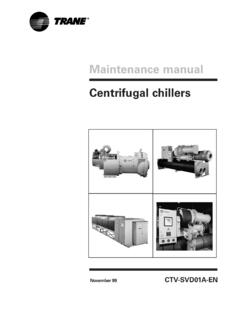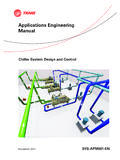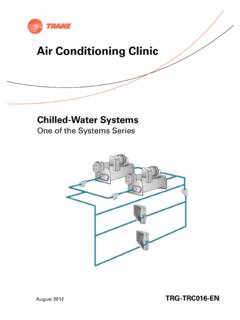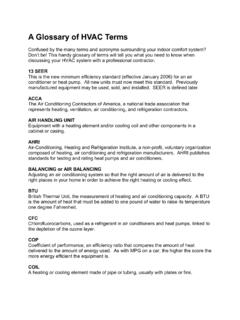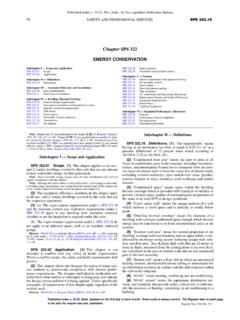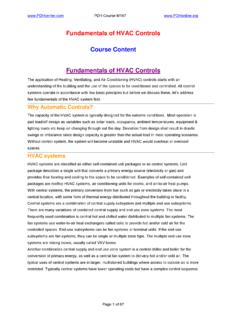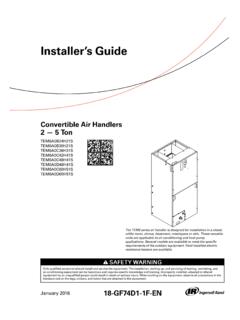Transcription of Cooling and Heating Load Estimation - Trane
1 air conditioning Clinic Cooling and Heating load Estimation One of the Fundamental Series April 2011 TRG-TRC002-EN. Cooling and Heating load Estimation One of the Fundamental Series A publication of Trane , a business of Ingersoll Rand Preface Figure 1. The Trane Company believes that it is incumbent on manufacturers to serve the industry by regularly disseminating information gathered through laboratory research, testing programs, and field experience. The Trane air conditioning Clinic series is one means of knowledge sharing.
2 It is intended to acquaint a nontechnical audience with various fundamental aspects of Heating , ventilating , and air conditioning . We have taken special care to make the clinic as uncommercial and straightforward as possible. Illustrations of Trane products only appear in cases where they help convey the message contained in the accompanying text. This particular clinic introduces the reader to Cooling and Heating load Estimation . It is intended to introduce the concepts of estimating building Cooling and Heating loads and is limited to introducing the components that make up the load on a building, the variables that affect each of these components, and simple methods used to estimate these load components.
3 It is not intended to teach all the details or latest computerized techniques of how to calculate these loads. If you are interested in learning more about the specific techniques used for Cooling and Heating load estimating, this booklet includes several references in the back. 2011 Trane . All rights reserved ii TRG-TRC002-EN. Contents period one Human Comfort .. 1. period two Cooling load Estimation .. 8. Outdoor Design Conditions .. 13. Conduction through Surfaces .. 14. Solar Radiation through Glass.
4 25. Internal Heat Gains .. 32. Infiltration .. 38. Ventilation .. 44. System Heat Gains .. 47. period three Psychrometric Analysis .. 50. Single-Space Analysis .. 50. Multiple-Space Analysis .. 60. period four Heating load Estimation .. 65. Outdoor Design Conditions .. 66. Conduction through Surfaces .. 67. Infiltration and Ventilation .. 69. period five Computerized load Analysis .. 73. Time Savings .. 73. Space versus Plenum Loads .. 75. Advanced Calculation Methods .. 77. period six Review .. 79. Quiz.
5 84. Answers .. 88. Glossary .. 92. TRG-TRC002-EN iii iv TRG-TRC002-EN. period one Human Comfort notes Cooling and Heating load Estimation period one Human Comfort Figure 2. Heating and air conditioning systems use the principles of heat transfer to maintain comfortable indoor conditions for people. Principles of Heat Transfer V Heat energy cannot be destroyed V Heat always flows from a higher temperature substance to a lower temperature substance V Heat can be transferred from one substance to another Figure 3.
6 The three basic principles of heat transfer discussed in this clinic are: 1) Heat energy cannot be destroyed; it can only be transferred to another substance. To produce Cooling , heat must be removed from a substance by transferring the heat to another substance. This is commonly referred to as the principle of conservation of energy. Ice cubes are typically placed in a beverage to cool it before being served. As heat is transferred from the beverage to the ice, the temperature of the beverage is lowered.
7 The heat removed from the beverage is not destroyed, but instead is absorbed by the ice, melting the ice from a solid to a liquid. TRG-TRC002-EN 1. period one Human Comfort notes 2) Heat energy naturally flows from a higher-temperature substance to a lower- temperature substance, in other words, from hot to cold. Heat cannot naturally flow from a cold substance to a hot substance. Consider the example of the beverage and the ice cubes. Because the temperature of the beverage is higher than the temperature of the ice cubes, heat will always flow from the beverage to the ice cubes.
8 3) Heat energy is transferred from one substance to another by one of three basic processes: conduction, convection, or radiation. Methods of Heat Transfer convection warm air radiation hot cool air water conduction Figure 4. The device shown is a baseboard convector that is commonly used for Heating a space. It can be used to demonstrate all three processes of transferring heat. Hot water flows through a tube inside the convector, warming the inside surface of the tube. Heat is transferred, by conduction, through the tube wall to the slightly cooler fins that are attached to the outside surface of the tube.
9 Conduction is the process of transferring heat through a solid. The heat is then transferred to the cool air that comes into contact with the fins. As the air is warmed and becomes less dense, it rises, carrying the heat away from the fins and out of the convector. This air movement is known as a convection current. Convection is the process of transferring heat as the result of the movement of a fluid. Convection often occurs as the result of the natural movement of air caused by temperature (density) differences.
10 Additionally, heat is radiated from the warm cabinet of the convector and warms cooler objects within the space. Radiation is the process of transferring heat by means of electromagnetic waves, emitted due to the temperature difference between two objects. An interesting thing about radiated heat is that it does not heat the air between the source and the object it contacts; it only heats the object itself. 2 TRG-TRC002-EN. period one Human Comfort notes Measuring Heat Quantity 1 lb water 1 Btu 60 F 61 F.

